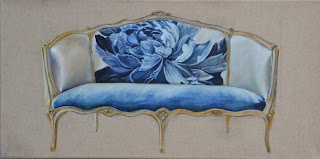"Peony", by Birgit Reiner, born in Sibiu, living in Bonn
60 x 30 cm, oil on canvas, march 2020
“Doesn't have this country other problems, then
collecting art?” Quite often I hear that question, when I introduce myself as
an art-collector living in Romania. Yes, the country has a lot of problems,
because the society is transforming from a strict conserving society into a
dynamic post-modern one. And in this process of transformation, which is
visible all over the world, not only in Romania, the individual is getting more
and more important. This development is visible In fashion, in travelling, in
food, in life-style as well in daily life and behavior of people. With this
development, parallel old traditions – or may I say retro fashions? – are coming
back, as collecting art.
There are an increasing number of Art-Collectors in Romania.
Nobody took the effort yet to analyze exactly the market-figures, because for
too long, collecting art had been considered in Romania as exotic hobby of a certain
elite, who wanted to show off with their collection their power and poverty. What surprises me and makes me happy in the
same way, that most Romanian Art-Collectors that I know are younger than me. This
is reflected as well in their collections, its style, the artists and artworks
which are represented in. The new Romanian collections are more open minded,
more international, more colorful. This development is a mirror of the
contemporary society in Romania. Most visitors, visiting the country are
surprised about its open mind, internationality and colorful life, especially
the art-scene in cities as Bucharest, Cluj-Napoca and Timisoara. The liberal
artsy spirit in this cities is determined of course by the international
art-universities, but as well in taking art serious again.
Since Adrian Ghenie broke through in 2006 and increased its
auction results at Sotheby’s 16 fold, art is considered as well as an
investment. From Ghenie, who is the most important representative of the “School
of Clu” and the art-center in the old brush factory (“Fabrica de Pensule”),
many Romanian businessmen learned how to make money with collecting art.
Nevertheless, Timisoara, European Cultural Capital 2021, and
Cluj-Napoca had been for Centuries part of the Austrian and later
Austro-Hungarian Empire, which brought as well the appreciation for Fine Arts
into bourgoise families.
Nowadays, Romanians are travelling a lot, living
abroad for some time and coming back, knowing how life could be. And they
observe that people in Western Countries decorate their homes and office with
original art. This is how usually, art-collections are starting. People find
out that the esthetic of contemporary art around, gives another mood, another
mind and makes us feel better, they continue searching for that moments of pleasure.
“When I look at Contemporary Art, a painting, a sculpture, a video-installation
and I remain looking at it, I feel better” the new, individualistic collectors
are reporting. And they learned to look
for artists from other countries and continents.
Romanian collectors of international contemporary art are
travelling to important fairs, discovering new artists, are curious about new
works of their favourite artist, build connections to galleries and curators
and ask for professional advice from art-experts. The recent
collector-generation are by profession lawyers, business-people from the
IT-Sector, from the Investment sector, real-estate developers and
industrialists. But we should not forget the huge amount of expats, coming from
other countries and staying in Romania for business, often employed by
multi-national companies with respectable income.
ART 9TEEN – Viennas Private Art Club & Events are
showing, now virtually on their website www.art9teen.eu
works by different Romanian collectors. Due to the current crisis, the
exhibition is now just virtually, but might follow real soon. “We want to show that Romania has serious
collectors of international Contemporary Art”, the organizers explain. Nevertheless,
Vienna’s art-world is curious, what is going on there in the almost forgotten
area of South-Eastern-Europe. Why cities as Timisoara, Cluj-Napoca and
Bucharest are the cultural hotspots between Vienna and Istanbul now? And why
galleries like Mihai Nicodim are in Bucharest and in Los Angeles, Plan B in
Cluj and Berlin, Kunsthaus 7B near Sibiu and in Vienna? Inspired from the
questions of the art-world outside Romanias, the team of ART9TEEN in Vienna
Döbling is preparing its virtual club-events for collectors and the next
exhibition with works from the portfolio of more Romanian collectors.
“Global Contemporary – Art from Romanian Private Collections”
